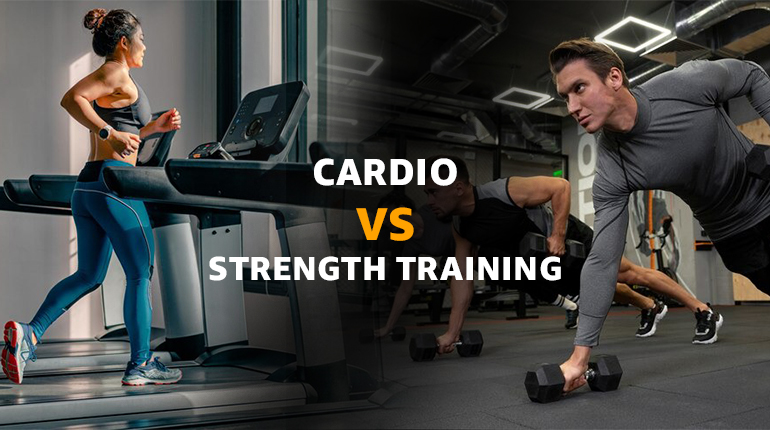When deciding on the best type of exercise, a common question is whether to prioritize cardio or strength training. Both offer distinct benefits, and the right choice depends on your fitness objectives, preferences, and health. This guide will explore the advantages of both cardio and strength training to help you decide which fits your goals—or if a combination is ideal for achieving the best results.
What is Cardio? Cardio, short for cardiovascular exercise, includes any activity that elevates your heart rate and promotes blood flow. It targets the heart and lungs, improving their function.
Popular forms of cardio include:
- Running or jogging
- Cycling
- Swimming
- Rowing
- Dancing
- Jump rope
Cardio exercises primarily focus on endurance, making them great for heart health and calorie burning. They can range from low-intensity activities like walking to high-intensity interval training (HIIT).
What is Strength Training? Strength training, or resistance training, involves exercises designed to build muscle and increase strength. It typically uses weights, resistance bands, or body weight.
Examples of strength training include:
- Weightlifting
- Bodyweight exercises (e.g., push-ups, squats)
- Resistance band workouts
- Powerlifting
- CrossFit
While cardio enhances endurance, strength training focuses on muscle development and increasing lean body mass.
Benefits of Cardio Cardio is often chosen for its direct benefits to heart health. It strengthens the heart and improves circulation by increasing heart rate. Other benefits include:
- Improved Heart Health: Lowers the risk of heart disease, high blood pressure, and cholesterol.
- Calorie Burning and Weight Loss: Cardio exercises like running and cycling burn significant calories, aiding in weight loss.
- Enhanced Endurance: Regular cardio boosts your body’s ability to use oxygen, improving stamina.
Benefits of Strength Training Strength training offers a different set of advantages, especially when it comes to building muscle and speeding up metabolism. Key benefits are:
- Muscle and Strength Development: Increases muscle mass and boosts overall physical power.
- Higher Metabolic Rate: More muscle means a higher resting metabolism, leading to more calories burned even at rest.
- Improved Bone Density: Lifting weights strengthens bones, helping to prevent osteoporosis and improve joint health.
Cardio vs Strength for Weight Loss Cardio is often the preferred choice for quick calorie burning. However, strength training also plays a critical role in weight loss. While cardio burns calories during exercise, strength training builds muscle, which continues to burn calories long after the workout.
- Cardio for Weight Loss: Great for immediate calorie burn.
- Strength Training for Weight Loss: Increases metabolism for sustained calorie burning after exercise.
Cardio vs Strength for Muscle Growth For those focused on muscle growth, strength training is the clear winner. Weightlifting and resistance exercises create micro-tears in the muscles, which repair and grow stronger.
- Strength Training for Muscle Growth: Stimulates muscle hypertrophy (growth) through resistance exercises.
- Cardio and Muscle Growth: While cardio can tone muscles, it isn’t as effective for building significant muscle mass.
Cardio vs Strength for Heart Health Cardio is well-known for its heart health benefits, but strength training also contributes by reducing blood pressure and improving circulation.
- Cardio for Heart Health: Directly improves heart rate, circulation, and lung capacity.
- Strength Training for Heart Health: Indirectly benefits heart health by lowering risk factors such as high blood pressure.
Cardio vs Strength for Mental Health Both cardio and strength training positively impact mental health. Cardio releases endorphins, reducing anxiety and stress, while strength training enhances self-confidence and provides a sense of accomplishment.
- Cardio for Mental Health: Great for relieving stress and boosting mood.
- Strength Training for Mental Health: Helps increase self-esteem and combats depression.
Time Efficiency: Cardio vs Strength In terms of time, cardio often requires longer sessions to match the calorie burn and muscle gains from shorter, intense strength training workouts.
- Cardio Time Commitment: Typically requires more time, especially for moderate-intensity activities.
- Strength Training Efficiency: More efficient due to the afterburn effect (EPOC), where you continue to burn calories post-workout.
Long-Term Sustainability Long-term sustainability varies from person to person. Cardio may be easier to maintain for those who enjoy outdoor activities, while strength training provides continuous progress through goals like lifting heavier weights.
Cardio vs Strength: Injury Risks Both forms of exercise come with injury risks:
- Cardio Injuries: Often from overuse, like runner’s knee or shin splints.
- Strength Training Injuries: Usually from improper form or lifting too much weight. These can be minimized with proper technique and gradual progression.
Cardio and Strength: Do You Have to Choose? The simple answer is no—you don’t have to choose. Combining both cardio and strength training can give you the best of both worlds, improving heart health, muscle strength, and overall fitness.
Which is Right for You? Your choice depends on your goals. Cardio is ideal for improving endurance and heart health, while strength training is best for building muscle and boosting metabolism. However, incorporating both into your routine is the best way to achieve a well-rounded fitness plan.
Conclusion Cardio and strength training each have unique benefits, and the best fitness plan often involves a combination of both. Whether your focus is on weight loss, muscle growth, or heart health, blending cardio and strength training can help you achieve balanced, long-term fitness.
FAQs
- Should I do cardio or strength training first?: If endurance is your goal, start with cardio. For muscle growth, prioritize strength training.
- Can I lose weight with just strength training?: Yes, it increases metabolism and aids in fat loss.
- How often should I do cardio or strength training?: Aim for 150 minutes of moderate cardio per week and at least two strength training sessions.
- What is the best type of cardio for beginners?: Walking, swimming, or cycling are great low-impact options.
- Can strength training replace cardio?: Strength training supports fat loss, but some cardio is important for heart health.
